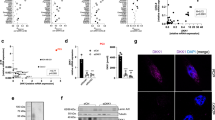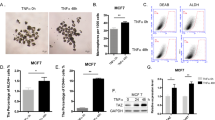Abstract
Potential crosslinks between inflammation and leukaemia have been discussed for some time, but experimental evidence to support this dogma is scarce. In particular, it is important to understand the mechanisms responsible for potential upregulation of proto-oncogenic growth factor expressions by inflammatory mediators. Here, we investigated the ability of the highly inflammatory cytokine interleukin-1 beta (IL-1β) to induce the production of stem cell factor (SCF), which is a major hematopoietic growth factor that controls the progression of acute myeloid leukaemia upon malignant transformation of haematopoietic myeloid cells. We found that human IL-1β induced the expression/secretion of SCF in MCF-7 human epithelial breast cancer cells and that this process depended on the hypoxia-inducible factor 1 (HIF-1) transcription complex. We also demonstrated a crucial role of the phosphatidylinositol-3 kinase (PI-3K)/mammalian target of rapamycin (mTOR) pathway in IL-1β-induced HIF-1α accumulation in MCF-7 cells. Importantly, mTOR was also found to play a role in IL-1β-induced SCF production. Furthermore, a tendency for a positive correlation of IL-1β and SCF levels in the plasma of healthy human donors was observed. Altogether, our results demonstrate that IL-1β, which normally bridges innate and adaptive immunity, induces the production of the major haematopoietic/proleukaemic growth factor SCF through the PI-3K/mTOR pathway and the HIF-1 transcription complex. These findings strongly support a cross-talk between inflammation and acute myeloid leukaemia.
This is a preview of subscription content, access via your institution
Access options
Subscribe to this journal
Receive 12 digital issues and online access to articles
$119.00 per year
only $9.92 per issue
Buy this article
- Purchase on Springer Link
- Instant access to full article PDF
Prices may be subject to local taxes which are calculated during checkout








Similar content being viewed by others
References
Broudy VC . Stem cell factor and hematopoiesis. Blood 1997; 90: 1345–1364.
Lee SJ, Yoon JH, Song KS . Chrysin inhibited stem cell factor (SCF)/c-Kit complex-induced cell proliferation in human myeloid leukemia cells. Biochem Pharmacol 2007; 74: 215–225.
Gibbs BF, Yasinska IM, Oniku AE, Sumbayev VV . Effects of stem cell factor on hypoxia-inducible factor 1 alpha accumulation in human acute myeloid leukaemia and LAD2 mast cells. PLoS One 2011; 6: e22502.
Han ZB, Ren H, Zhao H, Chi Y, Chen K, Zhou B et al. Hypoxia-inducible factor (HIF)-1 alpha directly enhances the transcriptional activity of stem cell factor (SCF) in response to hypoxia and epidermal growth factor (EGF). Carcinogenesis 2008; 29: 1853–1861.
Semenza GL . HIF-1 and tumor progression: pathophysiology and therapeutics. Trends Mol Med 2002; 8: S62–S67.
Sumbayev VV . LPS-induced Toll-like receptor 4 signalling triggers cross-talk of apoptosis signal-regulating kinase 1 (ASK1) and HIF-1alpha protein. FEBS Lett 2008; 582: 319–326.
Lall H, Coughlan K, Sumbayev VV . HIF-1alpha protein is an essential factor for protection of myeloid cells against LPS-induced depletion of ATP and apoptosis that supports Toll-like receptor 4-mediated production of IL-6. Mol Immunol 2008; 45: 3045–3049.
Nicholas SA, Sumbayev VV . The involvement of hypoxia-inducible factor 1 alpha in Toll-like receptor 7/8-mediated inflammatory response. Cell Res 2009; 19: 973–983.
Sumbayev VV, Nicholas SA . Hypoxia-inducible factor 1 as one of the “signaling drivers” of Toll-like receptor-dependent and allergic inflammation. Arch Immunol Ther Exp (Warsz) 2010; 58: 287–294.
da Silva CA, Kassel O, Mathieu E, Massard G, Gasser B, Frossard N . Inhibition by glucocorticoids of the interleukin-1beta-enhanced expression of the mast cell growth factor SCF. Brit J Pharmacol 2002; 135: 1634–1640.
Da Silva CA, Heilbock C, Kassel O, Frossard N . Transcription of stem cell factor (SCF) is potentiated by glucocorticoids and interleukin-1beta through concerted regulation of a GRE-like and an NF-kappaB response element FASEB J 2003; 17: 2334–2336.
Reber L, Vermeulen L, Haegeman G, Frossard N . Ser276 phosphorylation of NF-kB p65 by MSK1 controls SCF expression in inflammation. PLoS One 2009; 4: e4393.
Sims JE, Gayle MA, Slack JL, Alderson MR, Bird TA, Giri JG et al. Interleukin 1 signaling occurs exclusively via the type I receptor. Proc Natl Acad Sci USA 1993; 90: 6155–6159.
Nehme A, Edelman J . Dexamethasone inhibits high glucose-, TNF-alpha-, and IL-1beta-induced secretion of inflammatory and angiogenic mediators from retinal microvascular pericytes. Invest Ophthalmol Vis Sci 2008; 49: 2030–2038.
Sumbayev VV, Yasinska IM, Garcia CP, Gilliland D, Lall GS, Gibbs BF et al. Gold nanoparticles downregulate interleukin-1beta-induced pro-inflammatory responses. Small 2013; 9: 472–477.
Jung YJ, Isaacs JS, Lee S, Trepel J, Neckers L . IL-1b mediated up-regulation of HIF-1a via an NFkB/COX-2 pathway identifies HIF-1 as a critical link between inflammation and oncogenesis. FASEB J 2003; 17: 2115–2117.
Balkwill F, Mantovani A . Inflammation and cancer: back to Virchow? Lancet 2001; 357: 539–545.
Coussens LM, Werb Z . Inflammation and cancer. Nature 2002; 420: 860–867.
Frenz AM, Gibbs BF, Pearce FL . The effect of recombinant stem cell factor on human skin and lung mast cells and basophil leukocytes. Inflamm Res 1997; 46: 35–39.
Wang C, Liu J, Wang L, Geng X . Solubilization and refolding with simultaneous purification of recombinant human stem cell factor. Appl Biochem Biotechnol 2008; 144: 181–189.
Hanze J, Eul BG, Savai R, Krick S, Goyal P, Grimminger F, Seeger W, Rose F . RNA interference for HIF-1 inhibits its downstream signalling and affects cellular proliferation. Biochem Biophys Res Commun 2003; 312: 571–577.
Yasinska IM, Gibbs BF, Lall GS, Sumbayev VV . The HIF-1 transcription complex is essential for translational control of myeloid hematopoietic cell function by maintaining mTOR phosphorylation. Cell Mol Life Sci 2014; 71: 699–710.
Wiesner C, Nabha SM, dos Santos EB, Yamamoto H, Meng H, Melchior SW et al. C-kit and its ligand stem cell factor: potential contribution to prostate cancer bone metastasis. Neoplasia 2008; 10: 996–1003.
Abooali M, Lall GS, Coughlan K, Lall HS, Gibbs BF, Sumbayev VV . Crucial involvement of xanthine oxidase in the intracellular signalling networks associated with human myeloid cell function. Sci Rep 2014; 4: 6307.
Sumbayev VV . PI3 kinase and direct S-nitrosation are involved in down-regulation of apoptosis signal-regulating kinase 1 during LPS-induced Toll-like receptor 4 signalling. Immunol Lett 2008; 115: 126–130.
Schneiter R, Daum G . Analysis of yeast lipids. In: Methods in Molecular Biology, 313: Yeast Protocols. 2nd ed. Totowa, NJ: Humana Press Inc., 2006: 75–84.
Oehme F, Jonghaus W, Narouz-Ott L, Huetter J, Flamme I . A nonradioactive 96-well plate assay for the detection of hypoxia-inducible factor prolyl hydroxylase activity. Anal Biochem 2004; 330: 74–80.
Nicholas SA, Sumbayev VV . The role of redox-dependent mechanisms in the downregulation of ligand-induced Toll-like receptors 7, 8 and 4-mediated HIF-1 alpha prolyl hydroxylation. Immunol Cell Biol 2010; 88: 180–186.
Nicholas SA, Oniku AE, Sumbayev VV . Myeloid cell death associated with Toll-like receptor 7/8-mediated inflammatory response. Implication of ASK1, HIF-1 alpha, IL-1 beta and TNF-alpha. Mol Immunol 2010; 48: 240–247.
Author information
Authors and Affiliations
Corresponding authors
Rights and permissions
About this article
Cite this article
Wyszynski, R., Gibbs, B., Varani, L. et al. Interleukin-1 beta induces the expression and production of stem cell factor by epithelial cells: crucial involvement of the PI-3K/mTOR pathway and HIF-1 transcription complex. Cell Mol Immunol 13, 47–56 (2016). https://doi.org/10.1038/cmi.2014.113
Received:
Revised:
Accepted:
Published:
Issue Date:
DOI: https://doi.org/10.1038/cmi.2014.113
Keywords
This article is cited by
-
Biochemical mechanisms implemented by human acute myeloid leukemia cells to suppress host immune surveillance
Cellular & Molecular Immunology (2018)
-
Cortisol facilitates the immune escape of human acute myeloid leukemia cells by inducing latrophilin 1 expression
Cellular & Molecular Immunology (2018)



